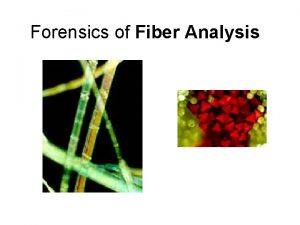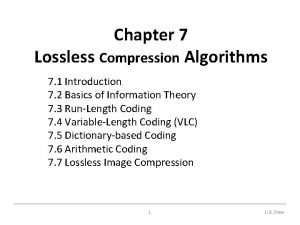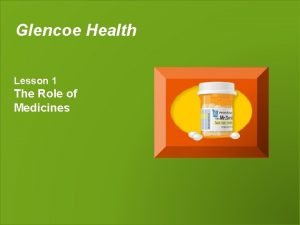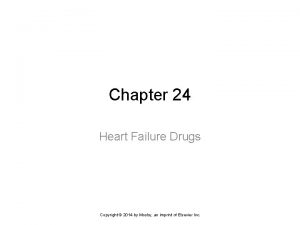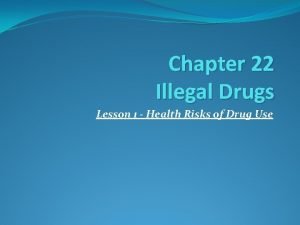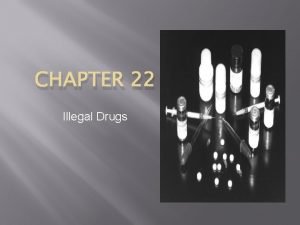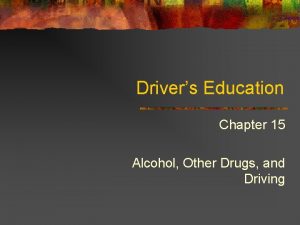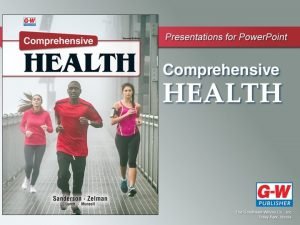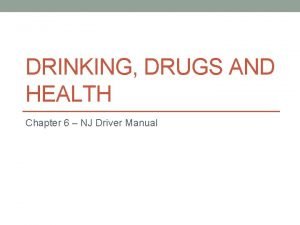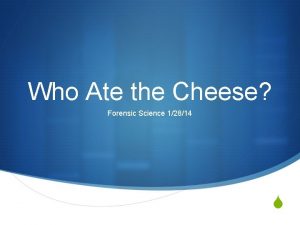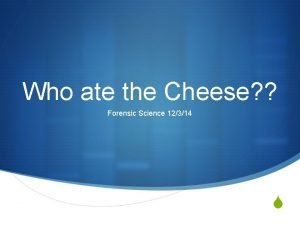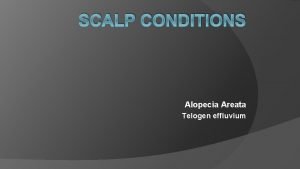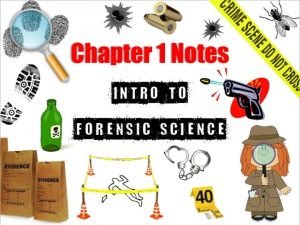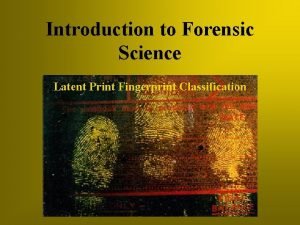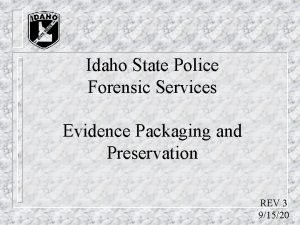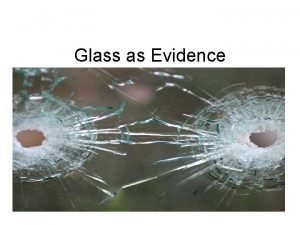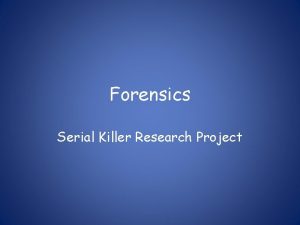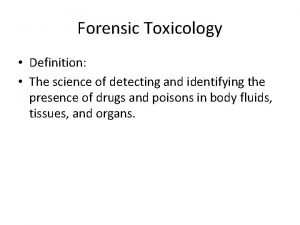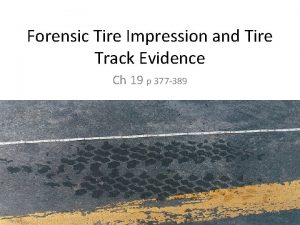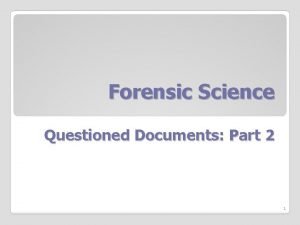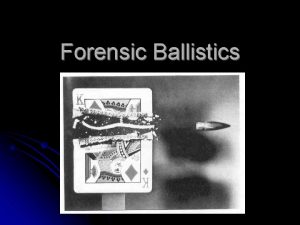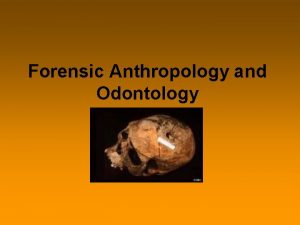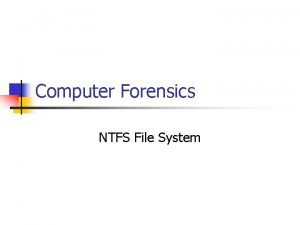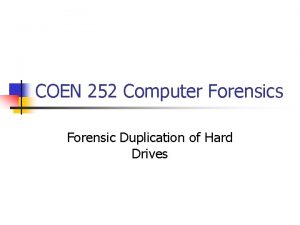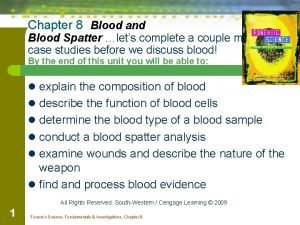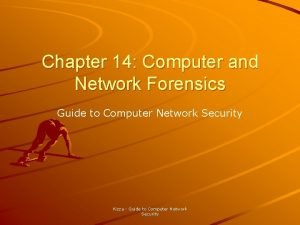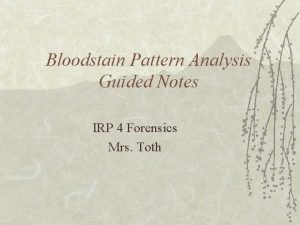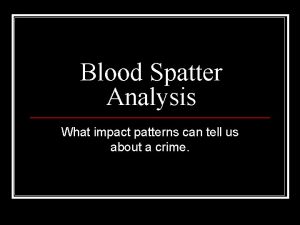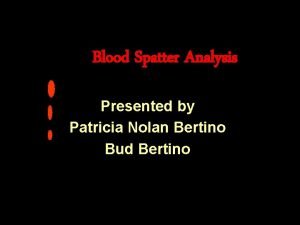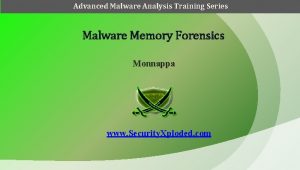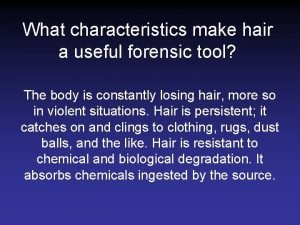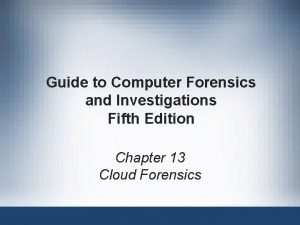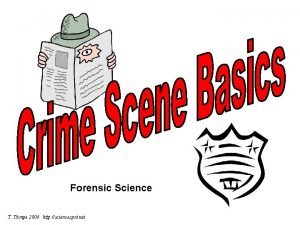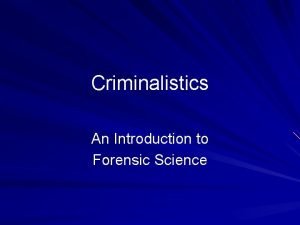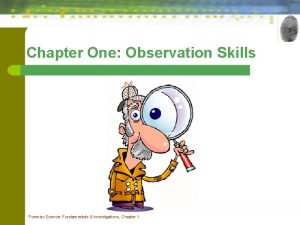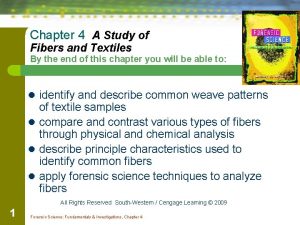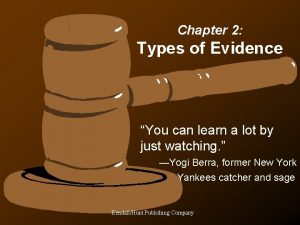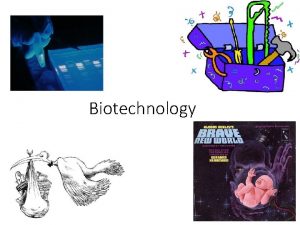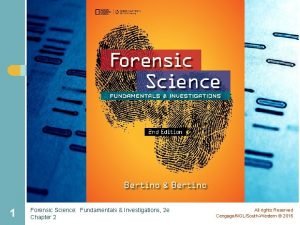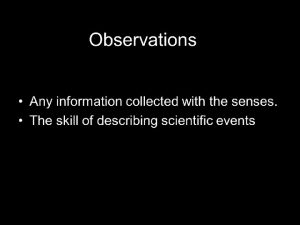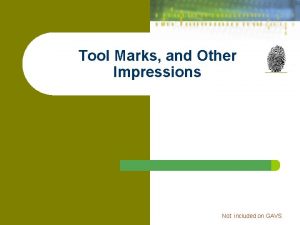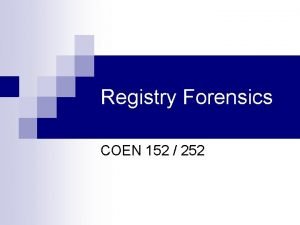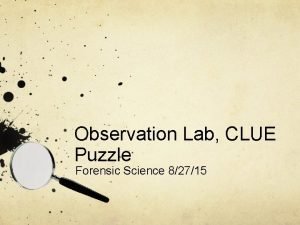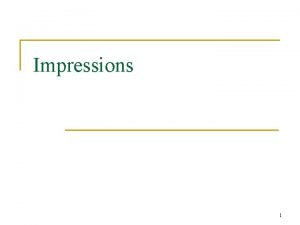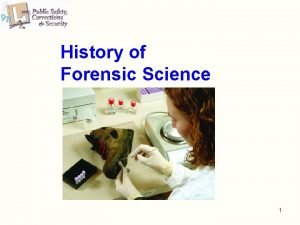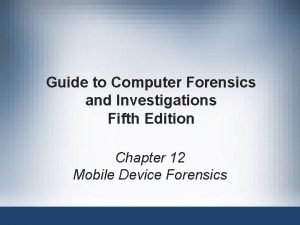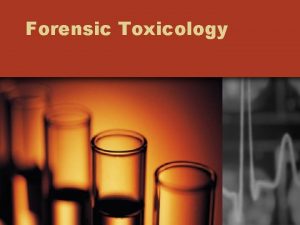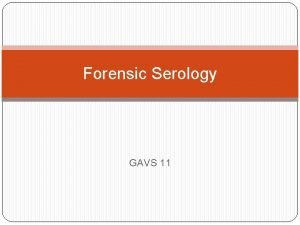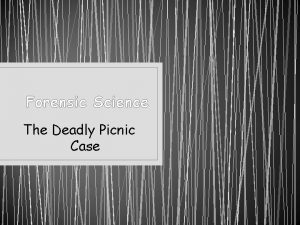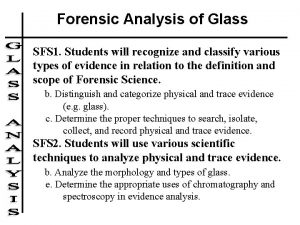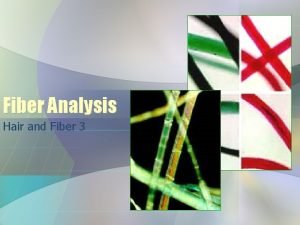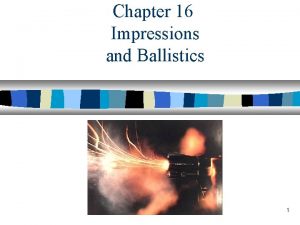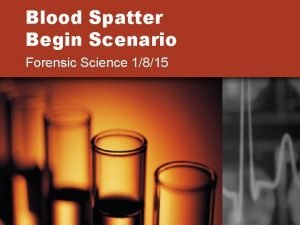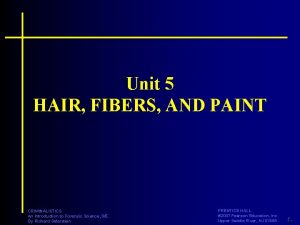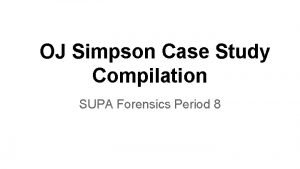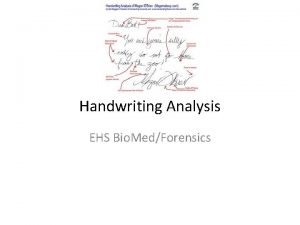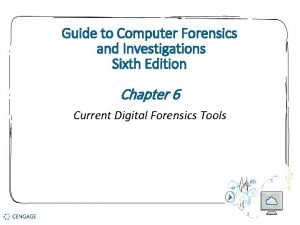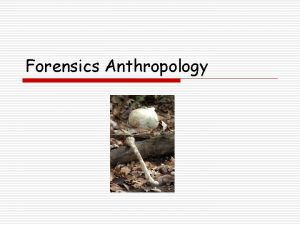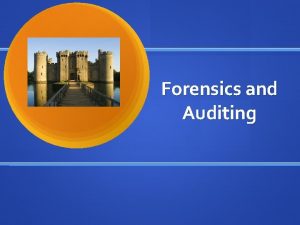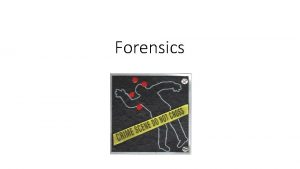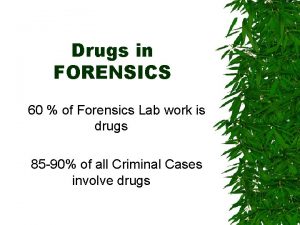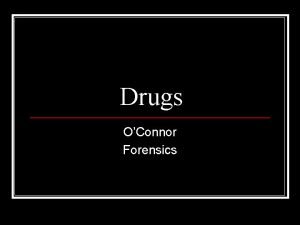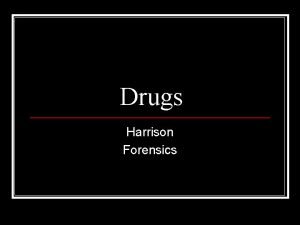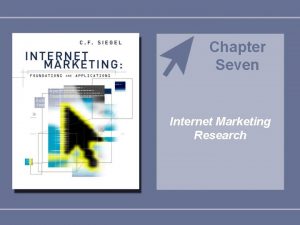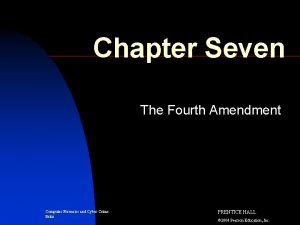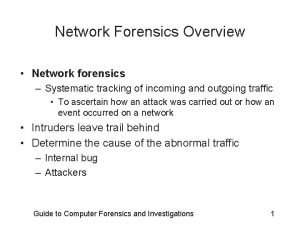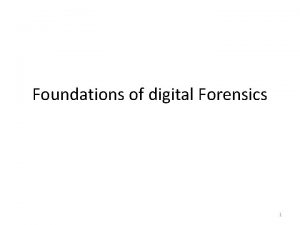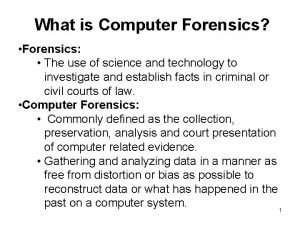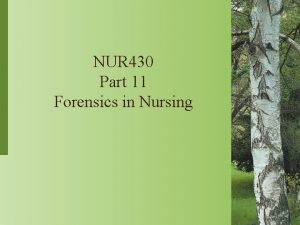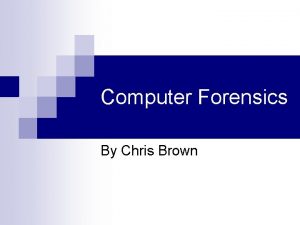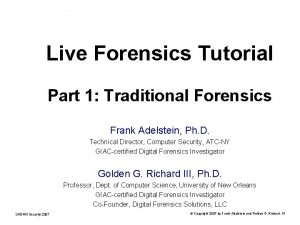Forensics Chapter Seven Drugs Drugs n A natural


































































































- Slides: 98

Forensics Chapter Seven: Drugs

Drugs n A natural or synthetic substance that is used to produce physiological or psychological effects in humans.

Drug Abuse Late 1800’s artists and upper class toyed with opium n 60 s first widespread abused n 70 s heroin chic led to disco powder n 80 s cocaine & crack epidemic n 90 s marijuana use skyrockets n – overall drug resurgence

Drug Abuse n 23, 000 illicit drug users – For many, drug effect lives in a negative way n 75% of evidence processed is drug related

Drug Dependence n Drugs were initially regulated due to addiction - “habit forming” – Opium & cocaine (once in Coke) – Marijuana added in 1930 s n Today many controlled substances are not very addictive

Drug Dependence Factors of drug Nature of drug n Route of administration n Dosage n Frequency of use n Individual’s rate of metabolism n Genetics n

Drug Dependence Other Factors Users personality n Expectations of drug use release, fun, or escape n Societies attitude n Peer group attitude n Setting drugs are used in n Availability n

Drug Dependence Addiction n Psychological Dependence - the emotional need for a drug – lifelong n Physical Dependence - the bodies craving for a substance, similar to hunger – easiest to overcome – withdrawal sickness - 3 days

Narcotics Alkaloids – powerful substances n Narkotikos - lethargy, sleepiness n Originally used for headache relief n Analgesics - pain relief n Opium - Asian plant, cutting through pod produces milky gummy juice n

Narcotics n Morphine - medical uses – civil war addicts Fentanyl – anesthetic n Heroin - morphine plus acetic anhydride n – snorted or injected – spoon, lanyard, needles – highly addictive – 3 to 4 hours of Euphoria

Narcotics n Heroin (con’t) – drug is 15%-65% pure – impurities could be anything n Codeine - 1/6 th as strong as morphine – “Robo-ing” for Robitussin n Methadone-opiate that is used to treat heroin users.

Narcotics n Pain Control – narcotics are primary treatment for pain – Many abused: • Oxycodone (Percocet, Percodan, Oxy. Contin) • Hydrocodone (Vicoden, Lortab)

Narcotics

Narcotics

Narcotics

Narcotics

Narcotics

Hallucinogens Alterations in normal thoughts, perceptions, and mood. n Marijuana - Cannabis sativa L. n – I. A. B. - actually another plant due to modern cultivation • Hydroponics n Hashish - plant resin, similar to pine sap in consistency

Hallucinogens: Marijuana Con’t Sinsemilla - unfertilized flowering tops of female, very potent n 3, 000 B. C. Chinese used it orally as a medicine n Hemp - fibers of plant wound up for rope n – G. Washington grew hemp NOT weed!

Hallucinogens: Marijuana Con’t Brought to Europe by Napoleon's troops n U. S. in the 1920’s by Mexican immigrants and U. S. soldiers n 1937 the first marijuana craze was on n – Reefer Madness – 46 states and Feds banned it

Hallucinogens: Marijuana Con’t Grows wild – “weed” n THC - Tetrahyrdocannabinol n – none in roots, stems, seed – highest in resin, flowers, leaves Natural is less than 1% THC n Street is 3. 5 to 8. 5%, (35% bud) n Hash Oil uses solvent to extract the resin - tar like - 20 -65% THC n

Marijuana Con’t Major harm is in regular use n THC is fat soluble n #1 - Brain n – Academic Performance – Cannibal Amotivational Syndrome n #2 - Gonads – 80% reduction in testosterone – 60% increase in birth defects (male)

Marijuana Con’t 350 carcinogenics n Accelerated cancer- throat, brain, lung n – 1 joint = 20 NON-filtered cigs – longer exposure, deeper inhalation Is now considered moderate to highly psychologically addictive n Still against the law n

Marijuana Con’t

Marijuana Con’t

Marijuana Con’t

Marijuana Con’t

Marijuana Con’t

Marijuana Con’t

LSD n n Lysergic Acid Diethylamide Synthesized from lysergic acid – derived from ergot, a rye fungus – not particularly hard to manufacture n n n 25 microg cause hallucinations that last 12 hours May cause chromosome damage Does not metabolize – flashbacks

LSD n Personality disorders – Alters brain scan profiles Occasional permanent effects n Sold in liquid, blotter paper, and sugar cubes, tablets n – Urban Myth that dealers use cartoons to lure kids into early use – Printing on blotter paper is a “branding of a particular lab

LSD

LSD

LSD

LSD

Psilocybin Found in certain mushrooms n Poisoning possible n

Peyote Spineless cactus n Used to find spiritual identity by some Native American tribes n STRONG hallucinogen n Full blown for 24 -72 hours n

Peyote

Other Abused Prescription Drugs n Various drugs are used – Some “off label” – Some veterinary drugs

Ketamine n Animal anesthetic – can be classified as a depressant and/or hallucinogenic n Special K, Vitamin K, Ket

Ketamine

Benzodiazepine Developed as a tranquilizer n Replaced many barbiturates n Very addictive n Very dangerous when mixed with alcohol, other drugs n Valium, Xanax, Lorazepam, Clonazepam n

Benzodiazepine

Phencyclidine (PCP) n Large animal tranquilizer – can be classified as a depressant Angel Dust n Major effects n

Phencyclidine (PCP)

MDMA Methylenedioxymethamphetimine n Ecstasy n “Designer Drug” n Street drug is usually heroin and cocaine mix n Fatal side effects n Possible chromosomal damage n

MDMA

Anabolic Steroids Little or no long term performance enhancement n Liver cancer and malfunction n Roid Rage n Sex problems n

Anabolic Steroids

Depressants -Alcohol Major impairment of judgement even at low doses n In-Toxic-Ation n – putting poison in body n #1 contributing factor in: death of males 14 -28, teen suicide, traffic accidents and fatalities, violence, rape, homicides, paralytic accidents, teen pregnancy, AIDS

Depressants - Barbiturates Downers n Derivatives of barbituric acid n – discovered by Von Bayer Quaaludes, Amytal, Nembutal, Seconal, Mebaral, Pentothal, Brevital and Luminal n Oral ingestion n

Depressants - Barbiturates

Inhalants AKA Deleriants n Popularized in early 60 s n First use drug - accessible n VERY DANGEROUS n Swiss cheese brain n Freon, Scotchguard n

Stimulants Amphetamines: Uppers, speed n Increasingly popular n Methamphetamines - crank, ICE n Highly addictive n Includes several weight pills n Crystal Meth now a major issue nationwide n

Stimulants

Stimulants

Stimulants Cocaine n Extracted from coca leaves n Crack - smokeable form of cocaine, similar to freebase n – highly addictable, low rehab %

Stimulants

Stimulants

Stimulants

Drug Evidence Collection Use common sense n Watch sharps/needles n We don’t swab our gums n Meth labs particularly dangerous n – Hazmat team required n Chain of custody is critical

Controlled Substances Act Schedule I—high potential for abuse; not currently accepted medical use in the U. S. ; a lack of accepted safety for use under medical supervision Examples: heroin (diacetylmorphine), LSD, marijuana, ecstasy (MDMA) Schedule II—high potential for abuse; a currently accepted medical use with severe restrictions; abuse may lead to severe psychological or physical dependence Examples: cocaine, morphine, amphetamines (including methamphetamines), PCP, Ritalin

Controlled Substances Act, continued Schedule III—lower potential for abuse than the drugs in I or II; a currently accepted medical use in the U. S. ; abuse may lead to moderate physical dependence or high psychological dependence Examples: intermediate-acting barbiturates, anabolic steroids, ketamine Schedule IV—low potential for abuse relative to drugs in III; a currently accepted medical use in the U. S. ; abuse may lead to limited physical or psychological dependence relative to drugs in III Examples: stimulants and depressants including Valium, Xanax, Librium, phenobarbital, Darvon

Controlled Substances Act, continued Schedule V—low potential for abuse relative to drugs in IV; currently accepted medical use in the U. S. ; abuse may lead to limited physical or psychological dependence relative to drugs in IV Examples: codeine found in low doses in cough medicines

Prohibition Big area of debate n Alcohol Prohibition n – failed – led to Mafia strength 4 in 10 Americans have tried illicit drugs n Gangs have exploded n Can’t really “socially” do drugs n

Forensics Chapter Eight: Toxicology

Toxicology “Study of Poisons” n In Georgia medical examiners offices and the GBI handle most toxicology needs n Alcohol major aspect of job n Drugs second n

Toxicologist n n Must figure out the impossible Relies on medical examiner, police, family to figure out what to look for 90% of the time it is alcohol and/or cocaine Looks for cause of death due to poisoning – Michael Jacksons death brought this role to public attention

Poisoning Heavy metals rare (arsenic, bismuth) - easy test n Carbon Monoxide very common n – look for carboxyhemoglobin – lack in blood from fire victim indicates they were dead before fire happened

Alcohol Absorption- 30 to 90 minutes, depends upon other factors- diet n Distribution- via blood n Elimination- oxidation and excretion n Equal amount in blood as in breath n

Alcohol Field sobriety tests n Used to determine impairment to justify tests n – horizontal gaze nystagmus – one leg stand – walk and turn n Covered in first year

Alcohol n Two main ways to test: – blood chemical analysis – breath tests Breathalyzer- determines alcohol by measuring light absorption before and after alcohol reaction n Intoxilyzer- uses infrared absorption to measure alcohol n – court admissible alone

Alcohol n Gas Chromotography used to determine Blood Alcohol Concentration (BAC)

Collection of blood Do not use alcohol disinfectant n Drawn and refrigerated n From deceased: Heart, Femoral, and Cubital n Blood samples still used in testing for drugs and severe car accidents n

Physicians’ Desk Reference PDR—A Physicians’ Desk Reference is used to identify manufactured pills, tablets, and capsules. It is updated each year. This can sometimes be a quick and easy identifier of the legally made drugs that may be found at a scene. The reference book gives a picture of the drug and states whether it is prescription, over-the-counter, or a controlled substance; it gives more detailed information about the drug as well.

Human Components Used for Drug Analysis Blood Liver tissue Urine Brain tissue Hair Kidney tissue Gastric contents Spleen tissue Bile Vitreous humor of the eye

Drug Identification Screening or presumptive tests Confirmatory tests Spot or color tests Microcrystalline test— a reagent is added, producing a crystalline precipitate that is unique for a certain drug Chromatography metry Spectrophoto • Ultraviolet (UV) • Visible • Infrared (IR) Mass spectrometry

Drug Identification, continued Screening or presumptive tests only tell that the drug is possibly present. Confirmatory tests tell that the drug is positively present. (Screening tests are easier, cheaper, and quicker to use. )

Presumptive Color Tests Marquis—turns purple in the presence of most opium derivatives and orangebrown with amphetamines Dille-Koppanyi—turns violet-blue in the presence of barbiturates Duquenois-Levine—turns a purple color in the presence of marijuana Van Urk—turns a blue-purple in the presence of LSD Scott test—color test for cocaine; blue

Chromatography A technique for separating mixtures into their components Includes two phases—a mobile one that flows past a stationary one The mixture interacts with the stationary phase and separates

Types of Chromatography Paper Thin-layer (TLC) Gas (GC) Pyrolysis gas (PGC) Liquid (LC) High-performance liquid (HPLC) Column

Paper Chromatography n n n The water is the mobile phase of the chromatography system The paper is the stationary phase. Chromatography works by something called capillary action: The attraction of the water to the paper (adhesion force) is larger than the attraction of the water to itself (cohesion force), hence the water moves up the paper.

Paper Chromatography n The material in the ink will also be attracted to the paper, to itself, and to the water differently, and thus a different component will move a different distance depending upon the strength of attraction to each of these objects.

Paper Chromatography n n To measure how far each component travels, we calculate the retention factor (Rf value) of the sample. The Rf value is the ratio between how far the component travels and the distance the solvent travels from a common starting point (the origin). If one of the sample components moves 2. 5 cm up the paper and the solvent moves 5. 0 cm, then the Rf value is 0. 5. You can use Rf values to identify different components as long as the solvent, temperature, p. H, and type of paper remain the same

Paper Chromatography Rf = distance traveled by sample component distance traveled by the solvent 2. 5 cm 5. 0 cm = 0. 5

Paper Chromatography n n n n Pencil Tape Paper Beaker Ink #1 Ink #2 Water

Paper Chromatography n n What was the MOBILE PHASE? What was the STATIONARY PHASE? Were the inks similar in composition? What evidentiary value does this have?

Thin-layer Chromatography Stationary phase—a thin layer of coating (usually alumina or silica) on a sheet of plastic or glass Mobile phase—a liquid solvent

Gas Chromatography Phases Stationary—a solid or a viscous liquid that lines a tube or column Analysis Shows a peak that is proportional to the quantity of the substance present Mobile—an inert gas like nitrogen or helium Uses retention time instead of Rf for the qualitative analysis

Uses of Gas Chromatography Not considered a confirmation of a controlled substance Used as a separation tool for mass spectroscopy (MS) and infrared spectroscopy (IR) Used to quantitatively measure the concentration of a sample. (In a courtroom, there is no real requirement to know the concentration of a substance. It does not affect guilt or innocence. )

Confirmatory Tests: Spectroscopy—the interaction of electromagnetic radiation with matter Spectrophotometer—an instrument used to measure and record the absorption spectrum of a chemical substance

Spectrophotometry Components A radiation source A frequency selector A sample holder A detector to convert electromagnetic radiation into an electrical signal A recorder to produce a record of the signal Types Ultraviolet Visible Infrared

Infrared Spectrometry Material absorbs energy in the near-IR region of the electromagnetic spectrum Compares the IR light beam before and after it passes through a transparent sample Result—an absorption or transmittance spectrum Gives a unique view of the substance; like a fingerprint

Mass Spectrometry Gas chromatography has one major drawback: It does not give a specific identification. Mass spectrometry cannot separate mixtures. By combining the two (GC-MS), constituents of mixtures can be specifically identified.

Mass Spectrometry, continued In a mass spectrometer, an electron beam is directed at sample molecules in a vacuum chamber. The electrons break apart the sample molecules into many positive-charged fragments. These are sorted and collected according to their mass-to-charge ratio by an oscillating electric or magnetic field.

Mass Spectra Each molecular species has its own unique mass spectrum.

IR Spectrophotometry and Mass Spectrometry Both work well in identifying pure substances. Mixtures are difficult to identify in both techniques. Both are compared to a catalog of knowns.

Forensics Drugs & Toxicology
 Fiber evidence is gathered with
Fiber evidence is gathered with Seven heavenly virtues mal
Seven heavenly virtues mal 7 wonders of the world
7 wonders of the world Natural hazards vs natural disasters
Natural hazards vs natural disasters Natural capital
Natural capital Chapter seven
Chapter seven Chapter 19 lesson 1 the role of medicines worksheet answers
Chapter 19 lesson 1 the role of medicines worksheet answers Inhibitions drivers ed
Inhibitions drivers ed Chapter 24 heart failure drugs
Chapter 24 heart failure drugs Chapter 22 illegal drugs lesson 1 worksheet answers
Chapter 22 illegal drugs lesson 1 worksheet answers Chapter 22 illegal drugs
Chapter 22 illegal drugs Chapter 15 alcohol other drugs and driving
Chapter 15 alcohol other drugs and driving Chapter 44 antiinflammatory and antigout drugs
Chapter 44 antiinflammatory and antigout drugs Chapter 11 medications and drugs
Chapter 11 medications and drugs Chapter 15 alcohol other drugs and driving
Chapter 15 alcohol other drugs and driving Good host law nj
Good host law nj Who ate the cheese forensics
Who ate the cheese forensics Who ate the cheese forensics
Who ate the cheese forensics What is forensic ballistics
What is forensic ballistics Morphology of hair forensic science
Morphology of hair forensic science Science olympiad forensics cheat sheet
Science olympiad forensics cheat sheet Telogen phase definition forensics
Telogen phase definition forensics What does pmi stand for forensics
What does pmi stand for forensics Bsapp forensics
Bsapp forensics Router forensics
Router forensics Forensic branches
Forensic branches Patent impressions are
Patent impressions are Idaho state police forensic services
Idaho state police forensic services Deer medulla pattern
Deer medulla pattern Becke line definition forensics
Becke line definition forensics Serial killer research project
Serial killer research project Forensics toxicology definition
Forensics toxicology definition Tire tracks forensics
Tire tracks forensics Diacritics definition forensics
Diacritics definition forensics How are striations internal ballistics created
How are striations internal ballistics created Subpubic angle definition forensics
Subpubic angle definition forensics Patent print forensics definition
Patent print forensics definition Inexpensive synthetic fiber that tends to ball easily
Inexpensive synthetic fiber that tends to ball easily Email forensics case study
Email forensics case study Ntfs architecture
Ntfs architecture Computer forensics report template
Computer forensics report template How to create forensic duplicate of a hard drive
How to create forensic duplicate of a hard drive Network forensics challenges
Network forensics challenges Directionality definition forensics
Directionality definition forensics Tabby fibers definition forensics
Tabby fibers definition forensics Forensic science chapter 17 review answers
Forensic science chapter 17 review answers Marks that are made when surfaces slide across one another.
Marks that are made when surfaces slide across one another. Network forensics tutorial
Network forensics tutorial Literary forgery forensics
Literary forgery forensics Literary forgery forensics
Literary forgery forensics Network forensics case study
Network forensics case study Wipe pattern forensics
Wipe pattern forensics Cast off pattern forensics
Cast off pattern forensics Angle of impact definition
Angle of impact definition Area of convergence blood spatter worksheet answers
Area of convergence blood spatter worksheet answers Memory forensics training
Memory forensics training Hair follicle definition forensics
Hair follicle definition forensics What characteristics make hair a useful forensic tool
What characteristics make hair a useful forensic tool Ics forensics
Ics forensics Hans gross forensic science
Hans gross forensic science Guide to computer forensics and investigations 6th edition
Guide to computer forensics and investigations 6th edition Google drive forensics
Google drive forensics Sciencespot.net
Sciencespot.net Defense forensics and biometrics agency
Defense forensics and biometrics agency Father of bloodstain identification
Father of bloodstain identification What is an observation in forensic science
What is an observation in forensic science Chapter 4 study of fibers and textiles
Chapter 4 study of fibers and textiles Transient evidence examples
Transient evidence examples Which career combines dna technology and forensics
Which career combines dna technology and forensics You're an eyewitness activity
You're an eyewitness activity Gillware digital forensics
Gillware digital forensics Bifurcation forensics definition
Bifurcation forensics definition Datum point forensics
Datum point forensics Francois-emanuel fodere
Francois-emanuel fodere 4.05 quiz: footwear and tire marks
4.05 quiz: footwear and tire marks Ntuser.dat file
Ntuser.dat file Forensics logic puzzle answers
Forensics logic puzzle answers Tool marks forensics
Tool marks forensics Social media forensics
Social media forensics Father of forensic serology
Father of forensic serology Fictional character
Fictional character Simcon forensics
Simcon forensics Forensics toxicology definition
Forensics toxicology definition Arterial spray definition forensics
Arterial spray definition forensics The deadly picnic answer
The deadly picnic answer Odontology definition
Odontology definition How to calculate adh forensics
How to calculate adh forensics Medulla hair
Medulla hair Adh forensics
Adh forensics Where does glass come from
Where does glass come from The most common type of plant fiber is
The most common type of plant fiber is Invented guns
Invented guns Area of convergence definition forensics
Area of convergence definition forensics Hair under microscope
Hair under microscope Supa forensics
Supa forensics Liport proxy
Liport proxy Digital forensics denver
Digital forensics denver Exemplar definition forensics
Exemplar definition forensics Building a forensic workstation
Building a forensic workstation
